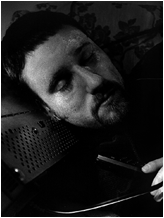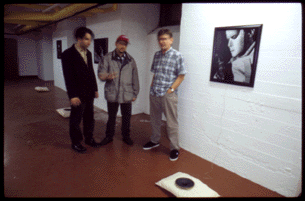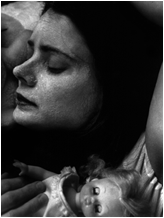
![]()
 |
 |
 |
||
It was the fanzine that led him to this: the blood smeared across her lips, the torso impaled, the guy in rubber with the oil can, the moaning and growling. Yeah. In many ways, it all began with the goddamned zine.
Mark Laliberte published Headtrip -- For the Tainted Intellectual when he was 17. It included comics by himself and Mike Diana of Boiled Angel infamy. In 1990, it was labelled obscene and was confiscated from comic book stores across Ontario. The police raided Laliberte's house and he spent two years "entangled in the gears of the creaking justice machine" before the judge deemed the images in Headtrip "tame and trivial as measured against the brutality, blood and gore readily observable" in the mass media of the time.
"The Headtrip Scandal took me out of an insularity and an innocence with my work and made me intently aware of an audience and of the power of the media on public perception. It made me more confident as a person with a strong voice," says Laliberte. "When we won the case, the media coverage reversed and they portrayed me as a protector of freedom of expression. That's how the public has treated me ever since. It has become a positive part of my personal mythology."
The events that shook up Mark Laliberte's young life were triggered by images -- lines he drew on a page. Ever since then, he's been exploiting the power that images can hold.
He's enhanced them with sound and turned their presentation into an immersive experience. His macabre audio installation, Pillow Scenes consists of photographs laid out on pillows with speakers inside playing tracks specially created to work with each image.
You hear that woman talking? Well, not actually talking. You hear the letter that begins each word, but the words themselves are just the sounds of silence dropped into the noisescape with the rhythm of speech. This is cut 7 on Laliberte's CD Pillow Scenes Soundworks 1996-1999. The track is called "Dumbtrack" and it goes with an image called "Microphonetic".
The cd text decribes the most recent Pillow Scenes installation called Labyrinth "...the audio-visual interplay draws the viewer into a space of perplexity, haunted by piecemeal meanings and ambiguous associations. The audio portion of a Pillow Scenes show drones on mysteriously; it loops and babbles away, and we wonder if here are clues to the unconscious life pulsing on ominously, absurdly, behind the eyes of the portrayed characters."
"The doors and the windows blew open, there was a small smouldering fire on the roof, and two employees who were inside were badly burned." The story is repeated over and over in an endless loop, first by a newsy male voice and then a female, "the doors and the windows blew open..." > from Channel (News Story), 1997
Obviously this work is intended to be disturbing. Does upsetting people give this guy some kind of validation?
After a lengthy pause, the artist replies, "I don't intend my work to be disturbing. I do become somewhat desensitized to my themes during the process of creation, so its always a shock to see someone become uncomfortable with the work."
Meanwhile, back at the Pillow Scenes installation; you're standing in a room filled with voices and tones and strange subdued sounds droning from every direction, ghosts competing for your attention. At eye level are pictures of people sleeping. Or dead.
If not intended to create discomfort, what exactly _was_ the artists intention?
"I guess my goal was to create a series of photographic anti-portraits and audio portraits."
Commercial photographers aim for really tight images that create specific connections between model and audience. Laliberte wanted to leave his character-driven images open to numerous interpretations. The audio tracks added more layers of meaning, encouraging the potential narratives to play off one another.
"I am interested in boundaries, edges, frames, screens, windows. All of these things are used to demarcate inside from outside, the two 'realities' that describe and define every aspect of the human condition. Exploring this demarcation is pretty important to my process both physically and psychologically.... I try not to consider cultural boundaries when working, try not to consider the differences between what critics may deem high or low, good or bad."
One has to wonder how his dark visions are accepted in the traditional art world.
"The public has this false notion that art galleries are sterile and safe places. The contemporary art world is a pretty decadent place. There is room for even the most extreme visions in the context of today's gallery system, and my work is pretty tame on the whole compared to the bleak worlds that some contemporary artists create.
"In Canada especially, there is a network of organizations that take the approach gallery as culture-lab, as a place for an artist to experiment."
If one of his installations shows up in the city where you live, freak out
your friends by taking them to an art gallery. They may go expecting some
climate-controlled institutional space full of pretty pictures. They may even
laugh at first, but they won,t be laughing later, after they've seen the blood
smeared across her lips, the torso impaled, the guy in rubber with the oil
can and they've heard the moaning and growling and whispering of ghosts.
Dale L. Sproule is a freelance writer; email him here